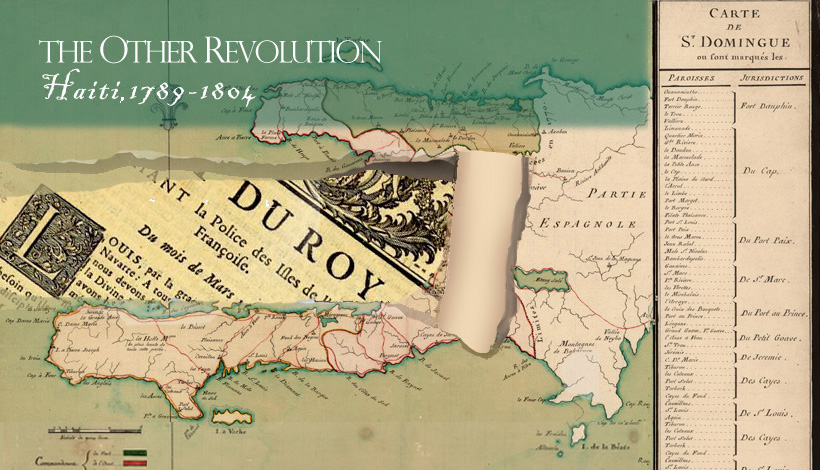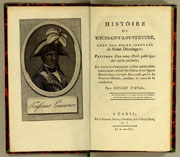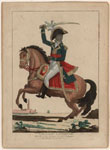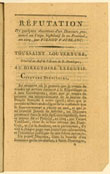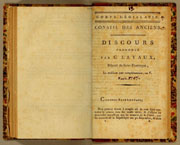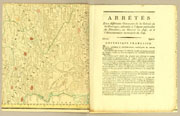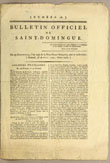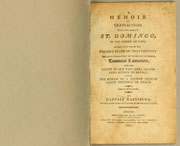vi. toussaint louverture (1797-1801)
|
||
First published portrait of Louverture This is the first published portrait of Toussaint Louverture. Although printed during his lifetime, it was probably not drawn from life. Arguably the most formidable and fascinating figure in the story of the Haitian Revolution, the man who called himself Toussaint Louverture (“the Opening”) was a free man before 1789, the coachman and manager on the Breda plantation near Cap Français. He was about fifty at the outbreak of the slave insurrection in 1791. As lieutenant to the insurgent generals Biassou and Jean-François, he wore the uniform of Spain. A devout Catholic, Toussaint distrusted the anti-religious and anti-royalist French revolutionaries. Even after the proclamation of general emancipation in October, 1793, Toussaint led anti-French troops besieging Le Cap. Finally, in May, 1794, because of the Convention’s abolition decree, Toussaint switched sides. Over the next seven years Toussaint united the entire island under his command, worked to revive the plantation economy, and proclaimed an autonomous constitution for Saint-Domingue with himself as governor for life. It was then that Napoleon took notice. |
||
Louverture at the height of his power |
||
Louverture responds to his critics By late 1796 Louverture had consolidated his control over the northern province, and in May 1797 Sonthonax named him commander in chief of French forces in the colony. The black leader’s rise to power made him a frequent target of attack in the metropolitan assemblies. In this reply to a speech by one of his most vociferous critics, Louverture rejected the suggestion that force was necessary to return the slaves to work. He also pointed to the French Revolutionary Terror of 1793-94 by way of arguing that the Haitian Revolution was not alone in resorting to the use of violence – a passage that suggests the involvement of someone trying to settle a score in the French domestic political situation. |
||
General Laveaux defends Louverture |
||
Former slaves support Louverture In January 1798 the Directory replaced Sonthonax with a former member of the military command that had handled the repression of the 1793 Vendée uprising in western France, General Gabriel Marie Théodore Joseph d’Hédouville. The ex-slaves instantly suspected Hédouville of wanting to return them to the plantations. Groups of former slaves around the colony drew up petitions asking Louverture to assume full control. A petition from the parish of Petite-Rivière, in the western province, is a rare example of a Haitian Creole document from this period. The former slaves declared their refusal to work until Moïse, one of Louverture’s military subordinates who led his men in an uprising against French authority, was released from prison. |
||
Louverture inspired by Declaration of the Rights of Man In August 1797 Louverture more or less forced Sonthonax out of the colony, leaving the black leader as the highest ranking official in Saint Domingue, general in chief of the French army. Stories about Louverture’s origins, his rise to prominence, and his ambitions for the future of Saint-Domingue circulated far and wide, in both the Caribbean and in France. In this January 1799 letter, an anonymous writer related the perhaps apocryphal story of Louverture reading the Abbé Raynal’s Histoire philosophiques et politiques des deux indes before the Revolution and taking inspiration from its foreshadowing of a Black Spartacus in the Caribbean. But it was the Declaration of the Rights of Man in 1789, we are told, that gave Louverture the actual idea for the role he would take. |
||
British visitor sees equality in Haiti This memoir by a British military officer who accidentally found his way to Saint-Domingue near the height of Louverture’s power provides a revealing glimpse of how foreign observers perceived the black general and Haiti. The American hotel in Cap Français where Rainsford stayed presented a “perfect system of equality,” with blacks and whites of different social ranks dining and conversing naturally with each other. When Louverture dropped in unexpectedly for dinner, Rainsford reports, he declined to take the head of the table. |
||
| Exhibition prepared by: Malick W. Ghachem (Massachusetts Institute of Technology), guest curator, with assistance from Susan Danforth (Curator of Maps and Prints, John Carter Brown Library). |
